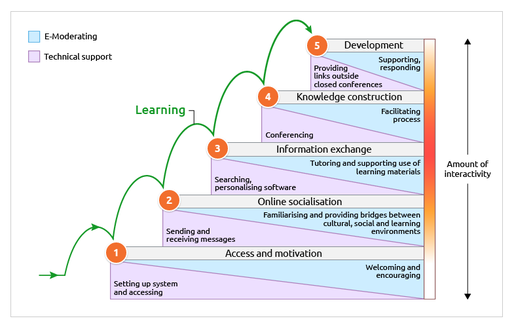During this weeks lecture in E-Learning Theories and Practices (EL6052), we discussed Gilly Salmon’s 5 Stage Model. Salmon’s model provides a scaffold for instructors to create constructivist learning environments. The MA covered constructivism theory in the first semester, and as I mentioned in a previous post, I took a 12 month leave of absence after the first year. So, to refresh my memory and in the hope of developing a better understanding of constructivism, I revisited my notes from the first semester.
This post briefly discusses the concept of constructivism and the 5 Stage Model. The post continues with my reflections on how my understanding of learning theories has changed since semester one.
What is Constructivism?
Constructivism emerged in the 1990s as a learning theory that suggests learners ‘construct knowledge’ from what they already know. They do this by relating course content to their pre-existing knowledge and real-life experiences instead of other theories that infer that learners passively consume information.
Constructivist theory insists that learning occurs when learners engage in group dialogue and participate in collaborative problem-solving activities. In this approach, the instructor facilitates learning rather than instructs learners on what to learn. Therefore, the instructor’s job is to present the learner with new problems continuously. Furthermore, the instructor must design ‘authentic’ learning experiences and actively encourage collaboration to facilitate deep learning. In using authentic learning experiences, “learners engage in activities which present the same type of cognitive challenges as those in the real world” (Jonassen 1999, p217).
There are three method’s to creating a constructivist learning environment, these are,
- Modelling
- The learner observes the instructor
- Coaching
- The instructor observes the learner
- Scaffolding
- A co-operative problem-solving effort
Modelling and coaching are both best used in onsite learning. However, scaffolding is preferred in the classroom and online learning, as it encourages independent learning.
Scaffolding the Constructivist Learning Environment
This week’s lecture discussed Gilly Salmon’s 5 Stage Model. Salmon’s model is a scaffolding framework that assists instructors (or E-Moderators) in developing an effective constructivist learning environment. In the model, the five stages are represented as stairs that the learner ascends until they become satisfied and successful learners who take responsibility for their learning.
Below is a diagram of Gilly Salmon’s 5 Stage Model.

The 5 Stage Model assists the instructor in designing and planning each step of the learning process. One of the model’s main objectives is to provide a framework for the instructor to allow collaboration and discourse. As I mentioned in a previous post, providing learners with an opportunity to develop a community is critical for learners to develop deep learning and understanding of the topic. Using this framework allows learners to ‘construct knowledge’ and become contributors rather than mere consumers of knowledge.
Theories in Practice
I do not have a teaching or an instructional background. So, as I began this MA, I was surprised and probably a little overwhelmed by the vastness of learning theories, frameworks and methods. However, I’ve since had the opportunity to use them in practice during the Interactive Courseware Workshop (EL6072). For this module, I co-created an Open Educational Resource (OER) with one other student. We incorporated the ADDIE model and integrated Gagne’s nine events of instruction and Bloom’s taxonomy during the course development. All of which I had never heard of before this MA. What I learned from creating that resource was that you do not need to have an in-depth knowledge of the theories and framework, like I initially believed. Instead, all you require is an understanding of when and how to incorporate the theories and frameworks into your course design.
As I prepare for my upcoming summer project, I plan to increase my understanding of learning theories, including constructivism. My goal is to understand better when each should be used and why. That understanding, I now believe, is a sign of a good instructional designer.
References
Jonassen, D. (1999) ‘Designing Constructivist Learning Environments’, in Reigeluth, C. M. (ed.) Instructional-Design Theories and Models: A New Paradigm of Instructional Theory, Volume II
Salmon, G. (2004) E-moderating. 2nd edition. London: RoutledgeFalmer